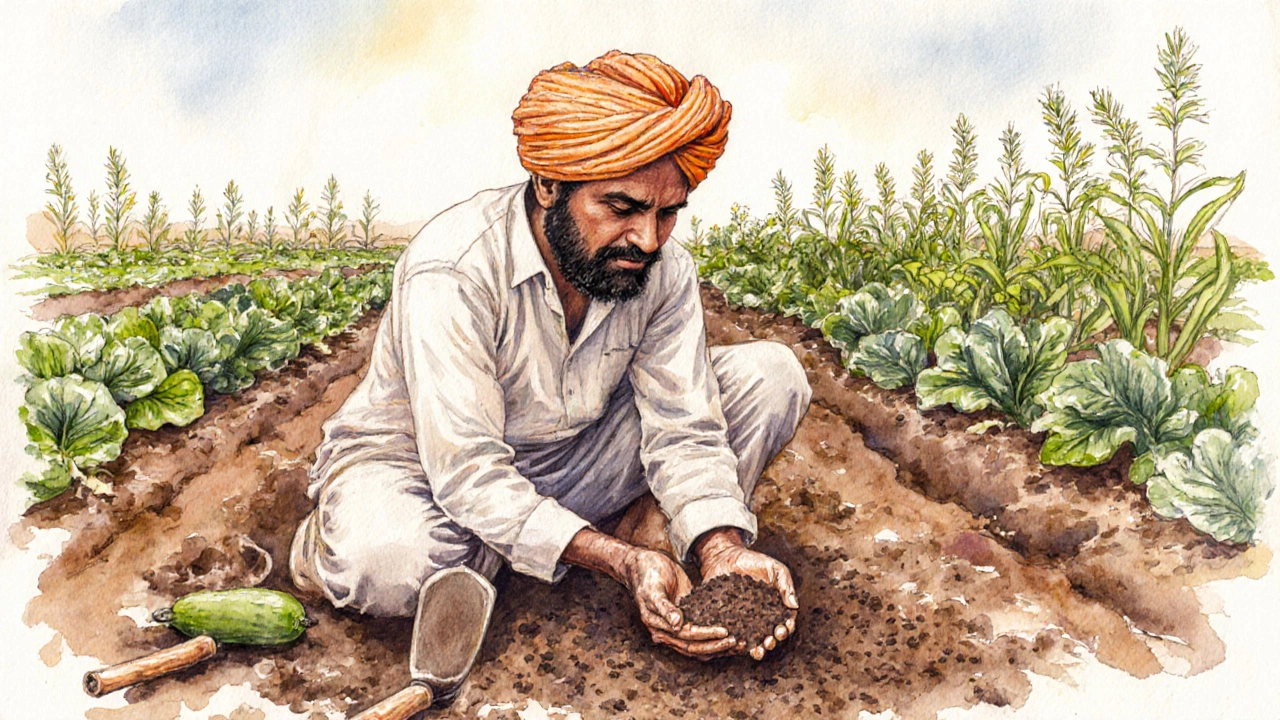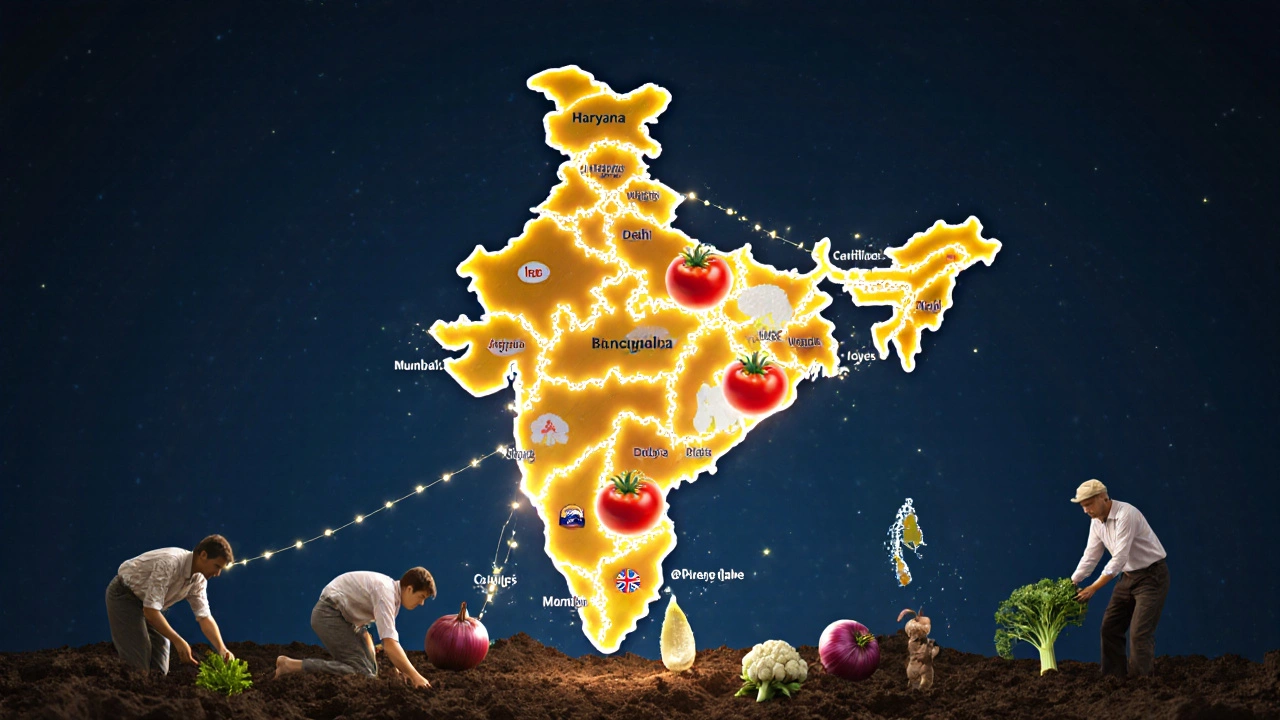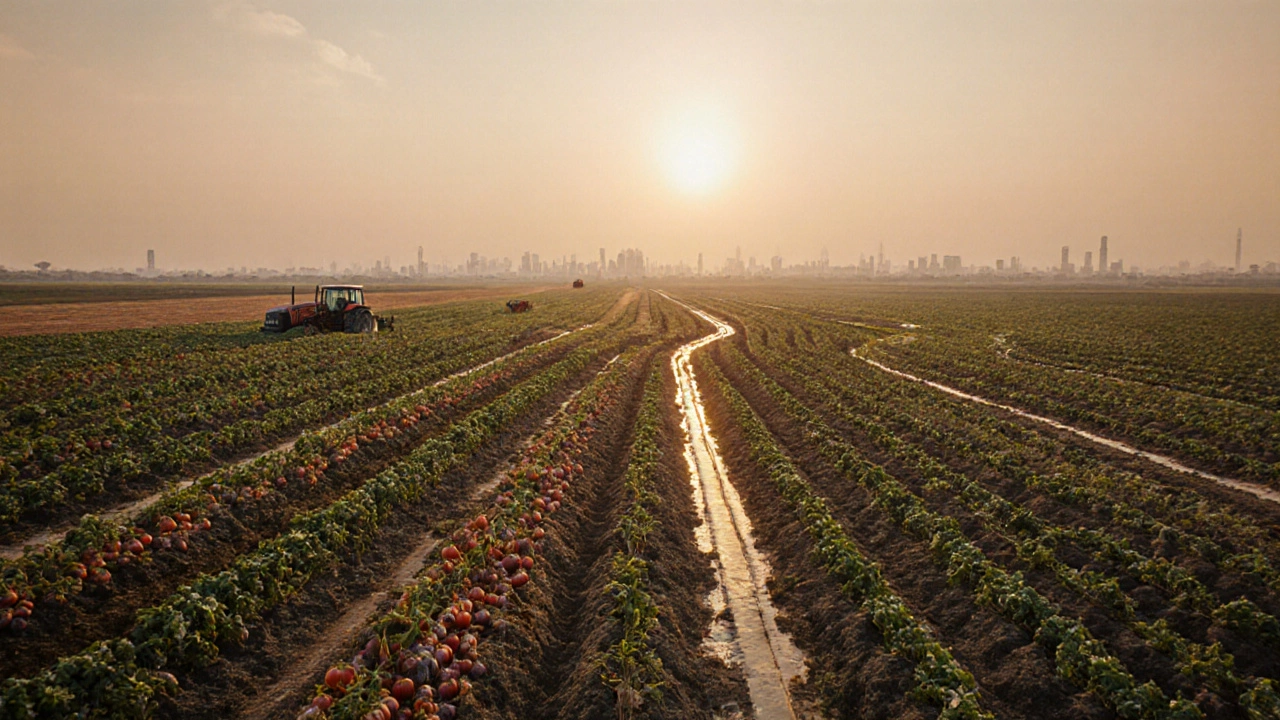Vegetable Yield Calculator: How Much Could You Grow?
Haryana produces 32 tons of tomatoes per hectare—nearly double India's national average. Using Haryana's proven farming methods, you can estimate your garden's potential yield.
Your Estimated Yield
Based on Haryana's average yields:
When you think of fresh, affordable vegetables in India, one state stands out-not because it’s the biggest, but because it’s the most consistent, the most diverse, and the most relied upon by millions across the country. Haryana is the vegetable capital of India. Not just a title handed out by marketers, but a fact backed by government data, crop surveys, and the daily supply chains feeding Delhi, Punjab, Rajasthan, and beyond.
Why Haryana Leads in Vegetable Production
Haryana doesn’t have the largest land area in India, but it has something more valuable: fertile soil, reliable water access, and farmers who treat vegetables like cash crops-not just side dishes. The state produces over 12 million metric tons of vegetables every year. That’s more than Maharashtra, Tamil Nadu, or West Bengal. It’s not just quantity, either. Haryana grows more than 40 different types of vegetables, from tomatoes and onions to cauliflower, spinach, and bitter gourd.
What makes Haryana different? Its location. It sits right next to Delhi, India’s biggest vegetable market. Farmers here can harvest in the morning and have their produce on shelves in the capital by noon. That means less spoilage, better prices, and more incentive to grow high-yield crops. The state government also runs training programs for farmers on organic practices, drip irrigation, and hybrid seed use-all of which boost output without harming the land.
The Numbers Don’t Lie
In 2024, Haryana accounted for 14% of India’s total vegetable production. Uttar Pradesh, often mistaken as the leader, produced 13.8%. The difference is small, but Haryana’s output is more consistent year after year. While UP sees big swings due to floods and monsoon delays, Haryana’s canal-based irrigation system keeps fields green even in dry spells. The state’s average yield per hectare for tomatoes is 32 tons-nearly double the national average of 17 tons.
Onions? Haryana supplies nearly 25% of India’s onion exports. Cauliflower? Over 30%. These aren’t random crops. They’re the ones that keep markets stocked and prices stable. When onion prices spike in Mumbai or Bangalore, it’s often because Haryana’s harvest was delayed by a week. That’s how central it is.
What Makes Haryana’s Soil So Good?
The soil in districts like Karnal, Kurukshetra, and Rohtak is a mix of alluvial and loamy clay. It holds water well but drains fast enough to prevent root rot. That’s perfect for vegetables like carrots, radishes, and potatoes-crops that need moisture but hate sitting in soggy dirt. Farmers here rotate crops every season. After wheat, they plant beans or spinach. After mustard, they grow cabbage. This keeps nutrients balanced and pests away.
Many small farmers use green manure-growing cowpea or sunhemp between main crops-and then plow it back into the soil. It’s cheap, natural, and works better than chemical fertilizers for short-cycle vegetables. The state’s Krishi Vigyan Kendras (Agricultural Science Centers) teach this to new farmers for free.

Other Major Vegetable Producers in India
While Haryana leads, other states play big roles too:
- Uttar Pradesh: Highest total production by volume, but more focused on staples like potatoes and cauliflower. Less diversity than Haryana.
- West Bengal: Leads in brinjal (eggplant) and okra. Strong in monsoon-season crops.
- Maharashtra: Major supplier of tomatoes and onions to western India. Uses more greenhouse tech.
- Andhra Pradesh: Growing fast in chilli and tomato production, especially in the Rayalaseema region.
But none match Haryana’s combination of scale, consistency, and variety. If you’re looking to understand how Indian vegetable farming works, Haryana is the model.
What This Means for Home Gardeners
If you’re growing vegetables in your backyard, balcony, or terrace, Haryana’s methods offer real lessons. You don’t need a hectare of land to copy what works.
- Rotate your crops. Don’t plant tomatoes in the same spot every year. Swap them with leafy greens or legumes.
- Use compost. Haryana farmers rely on it. Your kitchen scraps can do the same.
- Choose the right season. Haryana farmers plant onions in October for a January harvest. Match your planting to local frost dates and rainfall patterns.
- Focus on high-value veggies. Tomatoes, spinach, and radishes grow fast and sell well. Start there.
Even if you live in the UK, Australia, or Canada, these principles apply. The climate may be different, but the science of soil, rotation, and timing doesn’t change.

How Haryana Keeps Growing
The state doesn’t rely on luck. It invests. In 2023, Haryana launched the “Vegetable Mission,” a ₹2,000 crore program to help farmers buy drip irrigation kits, cold storage units, and solar-powered pumps. Over 80,000 small farmers got subsidies to upgrade. The result? A 22% rise in year-round production.
They also built 150 new mandis (wholesale markets) in rural areas so farmers don’t have to sell to middlemen at low prices. That means more money back into the soil, better seeds, and more innovation.
What You Can Learn From Haryana’s Success
You don’t need to be a farmer in India to benefit from what’s happening there. The real takeaway is this: vegetable gardening works best when it’s planned, not accidental. Haryana’s farmers don’t guess. They track weather, test soil, and time planting like clockwork.
If you’ve ever had a tomato plant that never fruited, or a patch of spinach that bolted too early, it’s not bad luck. It’s a timing issue. Haryana’s farmers solve that with data, not hope.
Start small. Pick one vegetable you love. Learn its ideal planting window in your zone. Use compost. Rotate next year. That’s the Haryana way-and it works anywhere.
Is Haryana really the vegetable capital of India?
Yes. Based on 2024 data from the Ministry of Agriculture, Haryana leads India in total vegetable production volume, diversity of crops, and consistency of yield. It produces over 12 million metric tons annually and supplies major markets like Delhi with over 40 types of vegetables year-round.
How does Haryana compare to Uttar Pradesh in vegetable production?
Uttar Pradesh produces slightly less than Haryana-13.8% vs. 14% of India’s total. But UP’s output is more variable due to flooding and monsoon dependence. Haryana’s canal irrigation and better soil management make its yields more stable, especially for high-demand crops like onions and tomatoes.
What vegetables are grown the most in Haryana?
Tomatoes, onions, cauliflower, spinach, potatoes, and bitter gourd are the top crops. Haryana is responsible for nearly 25% of India’s onion supply and over 30% of its cauliflower. These crops are grown in rotation across districts like Karnal, Kurukshetra, and Rohtak.
Can I grow the same vegetables in my garden as Haryana farmers?
Absolutely. The key is matching planting times to your local climate. Haryana farmers plant onions in October for January harvests. In temperate zones, plant them in late summer for fall harvests. Use compost, rotate crops, and choose fast-growing varieties like radishes and spinach to start.
Why is Haryana’s soil better for vegetables?
Haryana’s soil is a mix of alluvial and loamy clay-perfect for vegetables. It holds moisture without turning soggy, drains well, and retains nutrients. Combined with crop rotation and organic manure, this creates ideal conditions for high yields without heavy chemical use.
Next Steps for Gardeners
Want to grow like Haryana? Start this week:
- Test your soil pH. Most vegetables like 6.0-7.0. Use a $10 kit from a garden store.
- Plan your next crop rotation. Don’t plant tomatoes where you had potatoes last year.
- Start composting. Even a small bin can turn scraps into rich soil in 3 months.
- Choose one high-yield vegetable-tomatoes, spinach, or radishes-and grow it this season.
- Track your harvest. Note when you planted, when it grew, and what worked.
You don’t need a farm to think like a farmer. You just need to pay attention.


